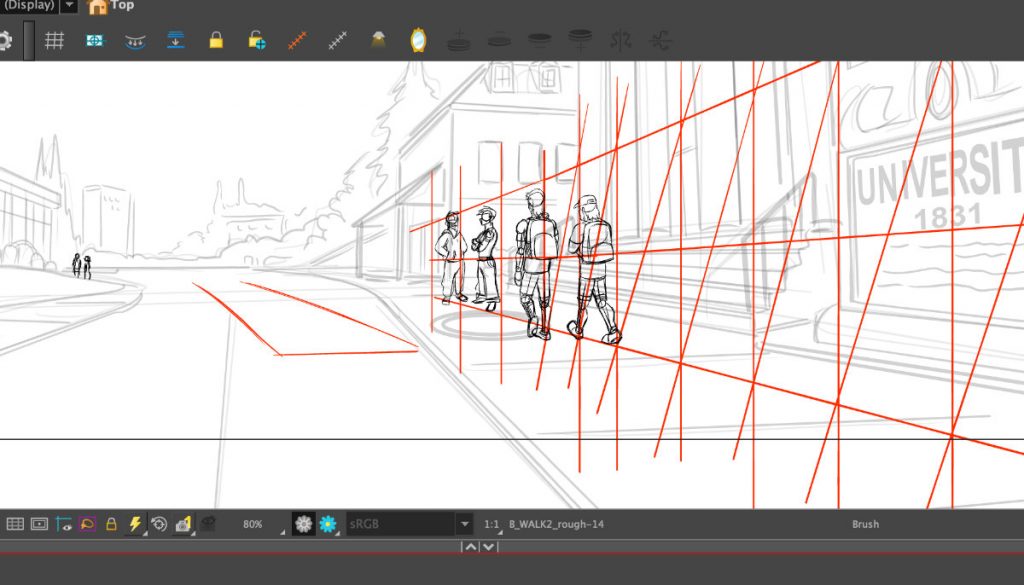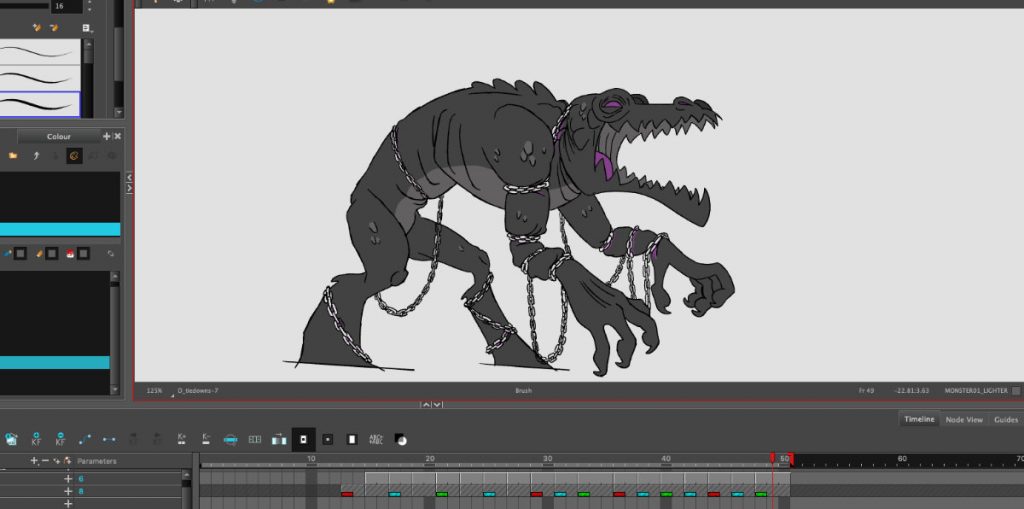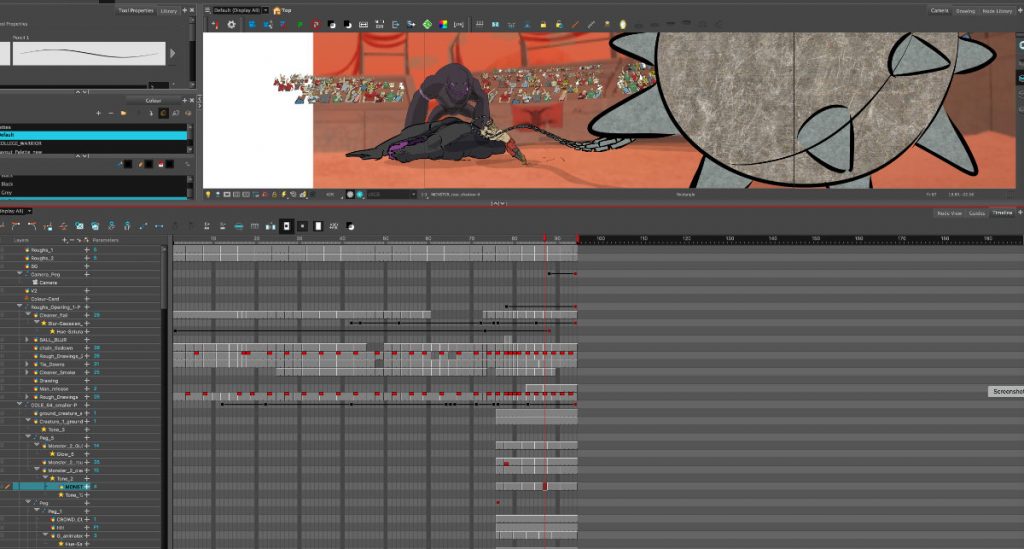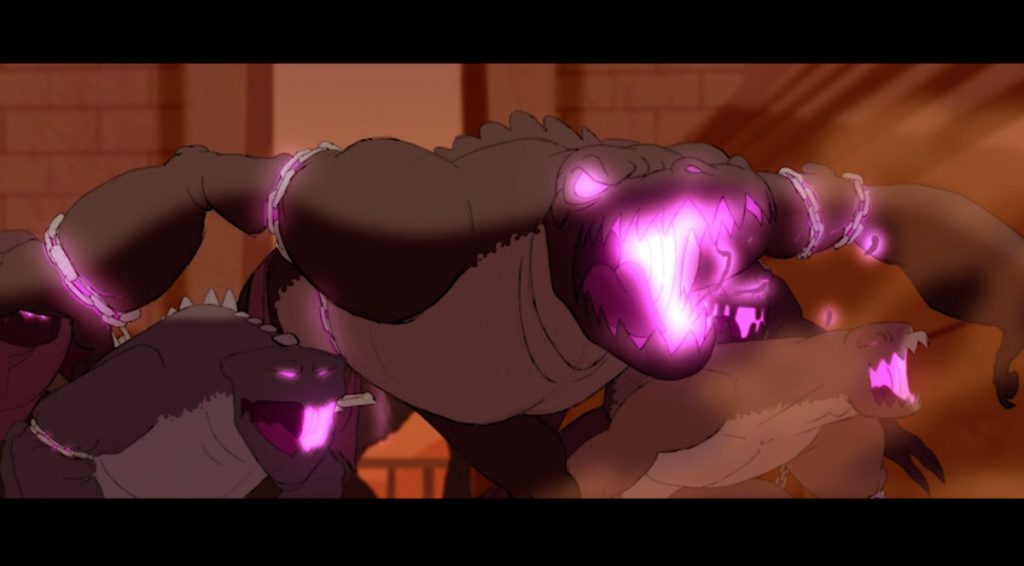Directed by Thomas Richner, ONE is an animated short film that explores the emotional journey of athletes moving from the highs of competitive sports to the reality of life beyond. ONE dives deep into those post-career challenges faced by athletes, vividly portraying the thrills of competition alongside the struggles around redefining yourself.
Thomas joined us with Aaron Cole (executive producer) to discuss the inspirations behind ONE, including their shared experiences as collegiate swimmers. They also touch on how their team used Storyboard Pro and Harmony to bring this powerful story to life, from character animation to shadow and compositing effects evoking the water’s ripples and refractions.
Through the highs and lows of the animation process, ONE not only comes together as a touching visual tale but also stands as an inspiration for those looking to reignite their passions. Read our interview below to gain insights into the technical aspects of animation production, the collaborative process between creators, and the challenges of expressing raw emotion through hand drawn digital animation.
Please introduce your animated short film, ONE…
Thomas: Set against the backdrop of competitive athletics, ONE is a heartfelt exploration of the journey an athlete takes as they transition from the highs of competitive sports to life beyond. ONE explores the emotional journey of athletes, capturing both the thrill of peak performance and the challenges of transitioning out of competitive sports.
Through the story of a swimmer confronting the void left after their athletic career ends, the film vividly portrays the camaraderie, triumphs, and intense adrenaline of competition, alongside the profound mental health challenges that can often follow once it ends. With themes of identity loss and rediscovery of purpose, the narrative ultimately offers hope and strength to anyone facing their own struggles. From Triumph to Trial: An animated journey illustrating the thrill of competition and the hidden battles after the final buzzer sounds.
At its core, it’s a story about putting your heart and soul into something and the loss that’s felt when it’s time to move on from it.

Who are the key team members and your roles on the project?
Thomas: Aaron Cole, the film’s Executive Producer — whose personal story the film is loosely based on — approached me a few years ago to tell a story he wanted to share about his challenges after his successful college swimming career came to an end. Aaron and I swam together for one year at Denison — it just occurred to me that this is another level to our film’s title. Aaron and I spent a year talking about the story, and while I directed the artists, Aaron and I had regular discussions about the film’s progress throughout production.
What experience that you shared inspired the project?
Aaron: The story was a reflection of my own experiences and was inspired by an awakening I had a few years ago. It was ignited by a few select conversations and friends I’ll forever be grateful to, who helped me realize I was not alone in the feelings and emptiness that came from the loss of sport.
Thomas: Upon graduation, I started swimming at UCLA Masters Swimming while in graduate school at the UCLA Animation Workshop. The transition out of sports might have been a little more gradual for me as I had a team that my wife and I trained with for seven years while we lived in California.
For anyone who has had something that was the focal point of their lives and then had it suddenly taken away, along with the sense of purpose and support system that went with it, I immediately related to Aaron’s story and the notion of a void left in one’s life. The story for us is very personal, touching on some of the feelings and traditions we shared in college.
But we also hope that anyone who shares a passion with others can relate to the notion of missing the camaraderie and fulfillment that came from it once that time in their life was over.

What has the critical reception been to the film so far?
Thomas: We’ve had three screenings in September of 2024, our first public screenings, and it’s been such a great experience so far. Our first public screening, which was technically our world premiere, took place at the BroodX Film Showcase in Toledo, Ohio on September 21. The festival, in its second year and run by Matthew Deimling Johns, was a blast, and we ended up winning the Audience Award, which was a great way to cap off the night!
We screened along with over a dozen other Ohio-connected animated films to open the Cartoon Crossroads Columbus event the following week. The screen was larger, and Aaron and I both commented that the film hit us a little harder watching it with that audience. The final screening on the Saturday was probably the most emotional for us as we screened it at our alma mater, Denison University, in front of many members and parents of our swim team. Of which my daughter is also a senior, graduating this year.
We had many swimmers talk to us afterward about how the film touched them, and they immediately got the core theme we worked to weave into the story, which makes a filmmaker feel pretty good. We got a number of texts and messages after these events, including one person saying they kept playing the film over in their head, and it spurred them to think hard about the next stages of their life.
As filmmakers and storytellers, honestly, if you can touch one person like that, it means the world to you! We are thrilled so far with the reception we’ve gotten from our screenings. We are still fairly early in our screening process, but we already have a European premiere scheduled this December in Palermo, Italy at the 44th Annual Paladino D’Oro Sports Film Festival and another festival set for March 2025 in Texas. We’re very happy with the start to rolling out the film.

Can you share your process for collaborating with the team on ONE?
Aaron: It was a new and exciting process for me, making a film for the first time. Honestly, in some ways, it was a huge weight off my shoulders that I didn’t know was there. I enjoyed expressing myself creatively through the story and stretching myself in new and very different ways.
Thomas: Aaron and I stayed in pretty close communication throughout the story development and animatic production. We used Storyboard Pro, as many professional productions do, to develop the story. We probably went through three to four versions of the story before we locked the animatic and moved into animation. Once animation started, our meetings became a little less frequent, as we met when we had a decent amount of work to review, and the film started to take shape. My job at that point, as director, was to communicate directly with the artists scene-by-scene.
I worked with my team of artists in much the same way many remote teams operate today, and it worked very well. I would kick off my artists with their sections of scenes through a Zoom call. Inside the Harmony scene files, I included many notes and sketches to help the artists get started on each scene. We would have them loosely block in the shot (with mostly keys and some rough breakdown drawings). Then I would review the scenes and give them a few notes to implement before they committed to finishing the animation.
All the animators did their own in-betweens, and we were very happy with the effort and quality we received from our team of artists, which ranged from newer animators still in school to young professionals to seasoned professionals with 25+ years of experience. Often, emailed notes were enough. But a sketch and a quick call could be even better at times. While we had a Dropbox set up for turning in scenes, since I was also acting as the production coordinator, I found it easier to collect scenes through email and manage the files on my own rather than having people placing files in folders (or moving files, deleting things) on Dropbox.

How would you describe the visual style of ONE?
Thomas: Dan Root, a 30-year industry professional, initially helped us with the look of the film. We gathered inspiration from projects that caught our attention. Then, I put that on the back burner in my mind and started reacting to the work coming in from my artists. Given that this was an independent short film with finite resources, we could make some course corrections here and there, but we couldn’t really redo large chunks of work. So, I saw my role as trying to make the work from many artists feel cohesive. Looping back to Dan, the first time he saw the film completed was at the Cartoon Crossroads Columbus event.
Dan, who animated on the original Space Jam and is a 30-year veteran of the animation industry, commented that he was impressed with how well the film visually fit together, and that felt really good. We did a lot of work on the color, and added some blur and black vignettes throughout the film, which I think visually pulled it together. I also added a film gate jitter throughout, which gave it both a film feel and a handheld quality. Given that water is a big part of the story, that subtle up and down movement of the picture helped immerse viewers into the story.
Which techniques within Harmony were most useful in creating the film’s visual style?
Thomas: I love how with Harmony you can use a combination of vector and raster images. All of our backgrounds were painted in Photoshop, and it was a pleasure processing every scene and seeing those backgrounds pop in behind the colored animation. The shot just comes to life. I probably used some keying here and there to add to the floating feeling of the characters underwater. I don’t know if I used it in every scene, but I always enjoy adding shadows on characters, and Harmony makes that process easy.
Even if you can’t afford to animate the shadows throughout the entire scene on every character, you can often create a shadow that a character moves out from, and there are ways to key shadow shapes to give it life over characters. Another technique I used inside Harmony was the Turbulence Node over water effects. We had several scenes where we didn’t want to distort the characters working over painted water, so the distortion effects came in very handy inside Harmony. As usual with Harmony, the coloring of the animation drawings was always smooth and fast! I also love how fast the paint dries inside Harmony compared to painting cels. That really streamlines the process.
One of the main things we did early on was to let the rough animation drawings show through the color of the characters. We had all the animators keep their rough drawings in the scenes, and I ran them through the tone module, so the rough lines showed through the animation in a darker version of the color on that part of the character. It was another attempt to keep a consistent look throughout — a loose feel to the animation. I believe that visually this helped the film feel connected. As an animator, I love seeing the initial roughs animators do when blocking in scenes, and I was happy to keep those drawings that often have the most life in the film.
For me, I love that Toon Boom’s products are built to give you flexibility, a wide range of different ways to work. And there are always five different ways to do something. If you want to achieve a look, and maybe you’re not super up to date on all the modules and what they do, you can often think about animation under that camera and come up with a combination of modules you are comfortable with to achieve the same effect. I do that a lot, and it always works!

What inspired the color palette you used in the short?
Thomas: We did some film studies early on where we looked at color schemes from films like Gladiator and some animated films like The Incredibles. We looked at color scripts for some of these films, and I would say they did inform our film. The scenes in the competition arena where the main character competes all had a red tint to them — tying them all together, separating them visually from the ‘real world’ scenes, and giving them a dusty, hot, intense feeling that felt right for the fight scenes.
We pushed the color to be cool and dark in the underwater scenes where our main character was lost and missing the sport that had been central to his life for so many years. We also tried to keep the color scheme simple. Some of the key colors were easy to select, as the mascot for our alma mater was the Big Red – so red was always going to be a central color in the film. Once that was locked in, the other colors mostly flowed from there in terms of what fit best.
How was your use of Harmony in this project similar to or different from other productions you’ve worked on?
Thomas: There were similarities and differences. Oftentimes, when you collaborate with studios overseas, you do still have studios using paper and scanning drawings into Harmony, so you have to keep the drawings registered throughout. In our production, the drawings were created directly in Harmony, so I could scale, move things around as needed. When you’re collaborating with different teams, you have to be very clear about the process you need to adhere to so that everything works from stage to stage.
When it’s just you processing the final art as it’s turned in, you can do what you need to do to make it work in the end. One of the nice things with Harmony is that you can shift the production and scene planning in so many different directions. We used Harmony like an old-school animation studio, drawing most of all our keys and in-betweens by hand. But you can work with puppet-style animation or rigged character animation inside of Harmony. This is what makes Harmony so powerful: the ability to push the program in any direction you need to serve the production, and most importantly, the story.

What advice do you have for those recently finishing their education in animation?
Thomas: First and foremost, do good work, whether it’s on a small side project, in a class, or wherever. Someone vouching for you is still most likely how you will find your first opportunities. Don’t work in a vacuum — connect with people, make friends, attend screenings, and connect with other artists. This is the network you’re building that will propel you through your career, and it starts as soon as you take your first class. The animation industry is small, and word gets around – do good work and protect your reputation by always giving every project your best effort.
The landscape is different in 2024 than it was in the 1990s. Simply having a film or some sample animation isn’t enough anymore because a lot more artists are out there doing fantastic work with powerful tools like Harmony and Storyboard Pro. So finding ways to stand out today is super important. And, as I think about it, maybe things haven’t changed as much as we might think because I still believe putting yourself in front of people physically is crucial. Live in areas where this work is being done and meet the people who are doing the work.
If that’s not possible, engage with people on social media, share your work, join Zoom events, and reach out to artists whose work you admire.
- While ONE is currently screening in competition at animation festivals, you can follow Cole Richner Productions on Instagram and YouTube.
- Are you ready to get started on your own independent horror film? Artists can download a free 21-day trial of Toon Boom Harmony.
The post Thomas Richner and Aaron Cole on diving into ONE appeared first on Toon Boom Animation.
Courtesy: https://www.toonboom.com/thomas-richner-and-aaron-cole-on-diving-into-one






